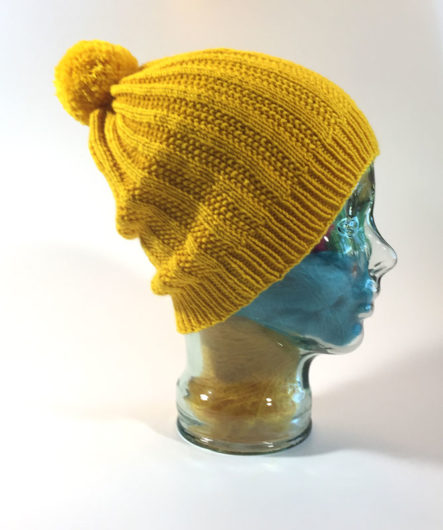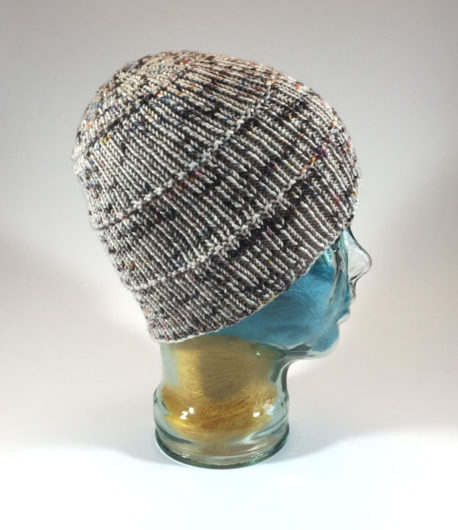This is Not Cabled, by Claudia Eisenkolb. You’ve seen it here before. This time I knit it in Plymouth Yarn Worsted Merino Superwash. This superwash is a favorite yarn of mine especially when stitch definition will really matter. My only modification was to use my regular long-tail cast-on rather than the recommended tubular cast-on. I knit all the rounds the pattern calls for in a large size and my gauge was true.
Here’s GlassHead modeling it:
One reason why I am likely this hat, a lot, is that it puts great texture on a head without squashing whatever hairdo is underneath. Many slouches look like they’d do that but turn out to be more like beanies with a rippled puff on top.
This next Not Cabled is knit in Jones Street Worsted by The Copper Corgi Fiber Studio. It’s 60% merino, 30% alpaca, and 10% silk. Jones Street is a beefy Aran weight, with good stitch definition, and a wonderfully soft feel. It’s another one of those budget-busting yarns that I reserve for special one-skein projects. I was confident Not Cabled would work well.
My stitch gauge was off a bit and my row gauge was off too. I liked the feel of the material at this gauge and, rather than move to a smaller needle, I figured following the pattern would basically work. All I did to modify the pattern was trim 6 rounds from the hat, moving from round 13 to round 20 on the second pattern repeat. To keep the not-cables lined up, I needed to adjust the end of round. I knit more stitches in round 13, beyond the end of row marker, so that the pattern would line up and still start round 20 with a purl 6, knit 2. It was a bit of trial and error–enough so that I can’t tell you exactly what I did– but it got sorted out. This version of Not Cabled has a snood quality to it. I like it!
Here’s a view of the nicely organized crown decreases.
Next up is the Ravelry freebie Koko Bean Hat by JudithMarieknits. I worked it in my trusty fav Plymouth Yarn Worsted Merino Superwash, this time in the Primavera colorway. There are many versions of this hat, copycatting a commercially produced hat that I’m unfamiliar with. This one’s a keeper.
It’s a well-behaved hat with a well-behaved crown decrease.
The next hat is Andi Satterlund’s Cabot. It shares some features of Not Cabed. It’s another good hat to prevent hat head and avoid bad hair days. I would tend to wear it to hide a bad hair day, though. I knit it back in 2014 in a two-color version, ahem, on account of I didn’t have enough yarn to knit it properly. I always meant to knit it again but it took me 5 years to cycle back around to it.

I’m pleased with the result. It’s best knit as Satterlund intended: one colorway. The textured triangle pattern is quickly mastered and makes for a fun and easy knit.
I worked my Cabot in the excellent worsted by Anzula: For Better or Worsted. It’s 80% merino, 10% cashmere, and 10% nylon: a warm, soft, bouncy yarn. The triangles even find expression in the crown decreases.
I’m thinking that 2020 is likely to be The Year of the Hat for me. Oh, wait. Every year for me turns out to be the year of the hat.
If you record each project on Ravelry and include the yardage used and then filter your project page by the year–2019–your total yardage knit during that year will appear at the bottom of the page. I knit 31,153 yards in 2019. This past year’s yardage total includes 51 hats. I think I got a bit carried away.



















